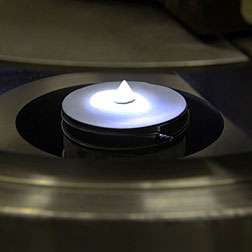Reinventing the power line cable

Materials scientists at the U.S. Department of Energy's Ames Laboratory are researching ways to perfect a next generation power cable made of an aluminum and calcium composite. Cables of this composite will be lighter and stronger, and its conductivity at least 10 percent better than existing materials for DC power, a growing segment of global power transmission. Its conductivity is about the same as that of existing conductors for AC power.
The cables used today, made of aluminum with a steel core, have been the industry standard for nearly half a century. They represent the best design thinking of the 1960's, said Ames Laboratory materials scientist Alan Russell, but they are a classic example of engineering "trade-offs."
"Pure aluminum power cable would be the perfect answer. Aluminum is light, highly conductive, easy to work with, and inexpensive. Its big failing is that it's too weak. If you put pure aluminum cables up, they would sag right to the ground," he said.
The steel core is necessary to hold them aloft, but adds weight and a host of difficulties in manufacturing, spooling, erecting, and maintaining traditional cable.
"The amount that aluminum and steel deform under elastic loading is different so you start to have problems with the fact you've got two very dissimilar metals clamped together. Then you add ice, plus wind, plus the occasional hurricane or tornado," said Russell, "and a cable of one uniform material begins to look immensely appealing."
Today's conductors transmit AC power well because AC current flows along the outside aluminum "skin" of the cable; the center section carries almost no current. For DC conduction, the entire conductor carries current, and the steel core contributes little, making it "dead weight". The new conductor under development at Ames Lab will carry current well through its entire cross section from skin to center.
The ultimate goal is a much improved alternative to traditional power cables.
Russell and his research team believe calcium is the answer. Added to aluminum in the form of small particles, the resulting composite is stronger, lighter and can lower overall costs to build new overhead powerlines comparedtotraditional steel-core aluminum cable. Lighter cable requires fewer support towers, which make up roughly half the total cost of constructing new power lines.
"Calcium is a really nice choice for a number of reasons," said Russell. "It's even lighter than aluminum, and among all the conductors available, it's the fifth best (after gold, silver, copper, and aluminum). It's abundant, ductile, and inexpensive."
But while calcium is the most attractive choice as a lightweight and inexpensive ingredient for a conductive composite, it is also proving the biggest hurdle. Calcium metal powder isn't readily available, and for good reason. Calcium is reactive with water, and a fine powder can react with humidity in the atmosphere.
"It creates the possibility of an explosion similar to one at a grain elevator. It can be dangerous to manufacture, and because there was no demand, no one was making it," said Russell.
And particle size is the key to the composite's strength.
"We need particles as small as 100 microns or less," said Russell, "If we plot what happens with particle size versus strength, as particle size goes down strength goes up."
Materials scientist Iver Anderson has been researching methods to safely produce the calcium in the needed form. In the lab's first attempt to form the composite into wire, done by a hot extrusion process, they used a form of calcium granules that were more readily available, and about 1.5 mm in size.
"That's very coarse," said Anderson. "In the extrusion process, you can imagine a 1.5mm sphere having to stretch down to a couple hundred nanometers. It isn't ideal, and that's our brick wall. So the question becomes, 'how do we get finer calcium?'"
The research team is exploring one very scalable possibility, as part of the research effort.
This calcium powder production method is centrifugal atomization, where a spinning disc intercepts a stream of molten calcium and flings off a spray of fine droplets. The droplets, less than one hundred microns in diameter, solidify as they cool and are captured in a quenching bath of hydrocarbon oil, which prevents the calcium from reacting.
"We know it's commercially scalable, and we're working with a company that uses the spinning disk method for the production of other metal powders. It would only take some minor modifications to their process to produce passivated calcium powder," said Anderson.
"There is nobody doing anything like this right now at a commercial scale, but that doesn't mean they couldn't," said Anderson. "The passivation provisions are very doable and should not add much cost."
Russell said the research team will be collecting data that will demonstrate the material's strength and conductivity by next year. He is confident they will see encouraging results. Anderson is confident too, and there is interest from industry and utility companies in the possibilities of a cable wound from this composite wire.
Provided by US Department of Energy





















